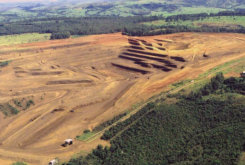Angola’s President João Lourenço has turned his attention to the port sector, both in an effort to assert his authority politically and also to improve the ports themselves. Angola has four main existing and planned ports running north to south: Caio in Cabinda, Luanda and the associated planned port of Barra do Dande, Lobito and Namibe, but Luanda is currently by far the most important. However, more capacity will be needed if the non-oil economy picks up as hoped, while mining export capacity is needed further south.
The situation could have been even more urgent had it not been for the economic downturn. Turnover at Luanda fell from more than 1 million TEU (twenty foot equivalent units – the unit of measuring container throughput) in 2014 to just 540,000 TEU in 2016 as imports plummeted, although they are now rising again. Sogester, a joint venture between international port operator APM Terminals (51%) and Gestão de Fundos (49%), has operated the second container terminal at Luanda, known as Sogester Container Terminal, since 2007.
Transportadora de Cargas, Operadora de Terminais e Transitário (Unicargas) has announced it will invest US$40 million in Luanda multipurpose terminal, including in paving the terminal area and purchasing new cargo handling equipment. The port is hemmed in by the city and so another port is planned at Barra do Dande, 30 kilometres north of Luanda.
Tender for Barra do Dande
However, the government has withdrawn a concession to build and operate Barra do Dande that had been offered to Atlantic Ventures.China Road and Bridge Corporation (CRBC) has a contract to build the project but work was delayed when low oil prices triggered an economic crisis. President José Eduardo dos Santos approved the development of the project by a company called Atlantic Ventures, with a US$1.5 billion price tag, just a week before he left office, although the project had originally been proposed in 2011.
Lourenço cancelled the deal when he took office. Both the awarding of the contract and its cancellation could be politically motivated, as dos Santos’ daughter, Isabel dos Santos, holds an unspecified stake in Atlantic Ventures. The company had threatened legal action against the revocation but the International Criminal Court has refused to intervene.
The company could seek compensation for the loss of its contract through other judicial means but this seems unlikely to be successful given that it has been widely reported that a binding contract was never signed. In July, the government announced that it would a launch a tender for a concession to design, build and operate the port. If it is to have dedicated container and dry bulk terminals as planned, a rail link to the Luanda Railway will probably be necessary.
Uncertainty over Caio
Caio in the northern enclave of Cabinda is the other greenfield port project with an uncertain future. Built relatively close to the mouth of the River Congo, its primary purpose is likely to be as a transhipment hub. Its depth alongside has been variously reported as 14 metres or 16 metres: the latter would make it the deepest port in Angola and capable of handling the same size ships as Kribi in Cameroon, Tema in Ghana and other container facilities under development in the northern Gulf of Guinea. Containers from very large vessels are unloaded at deepwater transhipment ports to be distributed to smaller local ports via feeder services.
The project plans were originally unveiled in 2007 but development has been delayed more often than even on Barrra do Dande. A concession to operate the port was awarded to Caioporto, with CBRC selected as the main construction contractor. China’s Export-Import Bank agreed to help fund the project.
However, it was revealed in June that the government of Angola wanted to cancel Caioporto’s contract. Another tender may be offered here on a project that is expected to cost US$832 million to construct. The container terminal is expected to have annual handling capacity of at least 1 million TEU, while a free trade zone and ship repair facilities are also planned.
CBRC’s success in securing contracts on Angolan port projects is not unexpected, as they are an obvious investment target for Beijing and Chinese companies. China has invested heavily in Angolan projects for many years, partly in order to ensure access to Angolan oil. Moreover, there has been lots of investment by Chinese firms in the African port sector recently, particularly by China Harbour Engineering Company and China State Construction Engineering Corporation. China Cosco Shipping has also launched more services to African ports, while China Merchants Group is developing port projects in Djibouti, with the intention of turning it into the ‘Shekou of East Africa’.
Japanese investment for Namibe
While Chinese investment has focused on the north of the country, Japanese companies are developing the port of Namibe in the province of the same name. In 2009, the Japanese government financed a feasibility study into port improvements, while Japan International Cooperation Agency funded US$20 million basic improvements undertaken by Japan’s TOA Corporation last year. These include paving the container storage area and strengthening a 240 metre stretch of the 480 metre quay.
In January, another Japanese firm Toyota Tsusho, announced that it is to invest 70 billion yen (US$643 million) in the port: borrowing half of the sum and sourcing the remainder out of its own resources. The government of Angola has approved Toyota Tsusho’s use of a line of credit that the Japan Bank for International Cooperation has opened up for infrastructural projects in Angola. Toyota Tsusho is heavily focused on the African continent, as 34 of the 39 countries that it operates in are on the continent. As almost always when state development organisations finance projects, Japanese companies are expected to secure the lion’s share of contracts at the port.
Port operations are currently restricted by the lack of cranes and other cargo handling equipment. The port has a depth alongside of just 10.5 metres, meaning that it can only serve relatively small vessels by current standards. Dredging would allow larger ships to call at the harbour but its role seems unlikely to extend much beyond that of a feeder port unless massive dredging is undertaken. The port will handle containers, iron ore, granite and possibly oil, presumably with at least three separate terminals, given the size of the investment planned.
Luanda operator Sogester has operated container and general cargo operations at the Port of Namibe under a 20 year concession since 2014. It remains to be seen what impact Toyota Tsusho’s contract will have on Sogester’s concession. The Japanese firm seems unlikely to take over as operator.
Namibe is connected to the rest of southern Angola by the Moçâmedes railway, otherwise known as Caminho de Ferro de Moçâmedes (CFM), which runs 860km east to Menongue. It was built under Portuguese rule to allow iron ore and agricultural commodities to be exported. The CFM was completely redeveloped between 2006 and 2014 at a cost of US$1.2 billion.
Macauhub reported in July that CFM had agreed to increase the number of freight trains running on the line from two to five a week, and to reduce the cost of transporting granite along the line from 7.5 kwanza per kilometre to 6.5 kwanza per kilometre.
The governments of Huila and Namibe provinces have sought to force granite to be transported by rail rather than road because of the damage caused to roads in the region by road haulage. Almost all production is exported and in 2017 34,334 cubic metres of granite were exported via the railway and port of Namibe to Western Europe, India and China. The line and port will also handle marble exports.
Copper shipments from Lobito
The port of Lobito is also now shipping mining exports. It handled copper mined in the Democratic Republic of Congo (DR Congo) last year after a gap of more than 30 years. The rehabilitation of the 1,344 kilometre Benguela Railway eastwards across central Angola and over the border into DR Congo means that the port can once against target Congolese mining exports.
Copper and other mining commodities produced in the south-eastern Congolese Katanga provinces have mainly been exported via Dar es Salaam and South African ports but Lobito is a viable alternative and offers far shorter sailing times to Western Europe and the US. The first consignment of copper transported on the line, in March 2018, was actually bound for India.
The chairman of the port infrastructure management company, Augustine Estêvão Felizardo, commented: “The port of Lobito intends to show the international community that these ore shipping operations are already possible.” Manganese has also been carried along the line to the port, while it is now possible that Zambian copper could be exported along the same route. The government of Zambia received a US$8.1 million grant from the African Development Fund last year towards developing its own connection to the Benguela line.
Julien Rolland, amember of Trafigura’s management committee, told Mining Weekly: “It has the potential to mark the beginning of a new chapter in the history of a railway line that dates back more than a century and once took millions of tonnes of cargo from the mines of the Congo to the ocean port of Lobito. We intend to play a leading role in re-establishing this route, which still needs investment in the DRC railway. A properly functioning Lobito corridor would take days off the journey time to a world class port that offers the fastest access to American and European markets.”



